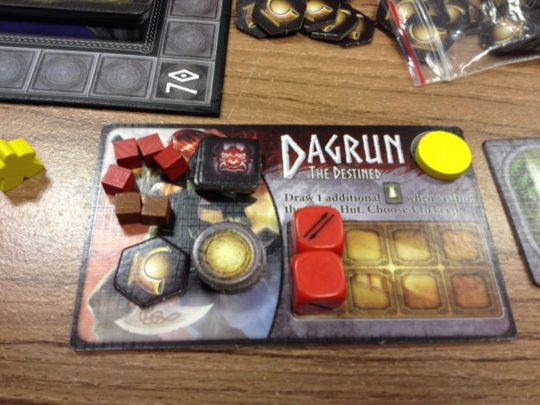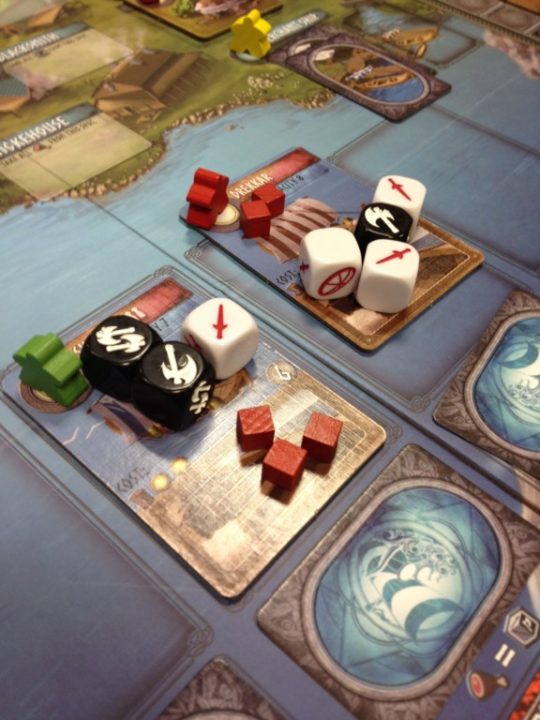“Wake early if you want another man’s life or land.
No lamb for the lazy wolf. No battle’s won in bed.”
~ The Havamal
Players are leaders of Viking clans who have travelled to an embattled Viking harbour town to help defend it against the threat of trolls, draugr, and other mythological Norse beasts. By defeating these epic creatures, players gain glory and the favour of the gods.
Champions of Midgard is a quite basic worker placement game. It gets compared a lot to Lords of Waterdeep for its simplicity but there’s more to it than that game.
You have a player board with an ability which you’re supposed to draft in reverse turn order but I just dealt them out for now. The abilities were strong but fairly balanced from what I could tell from this one game.
You have a few starting resources and you’re good to go. You start with some white dice and in this game dice represent your Warriors.

Dice
The dice in Champions of Midgard comes in 3 colours.
White has Swords and Shields, Red have Spears and Shields and Black has just Axes. They each have a combination of 1 or 2 symbols per side (representing 1 or 2 hits) and a decreasing number of blank sides in the order I listed them. These are used for hunting and fighting Trolls, Dargur and Monsters but there is a long way to go before we talk about that.
The main board has all the spots for placing workers and is divided into different colours. Brown and Blue spaces are activated immediately while Red ones are activated in the next phase.

Worker Placement
The main spaces let you gain Warriors and Food and also let you trade resources 1 for 1 in the supply. There is also the standard “Take the 1st player marker” space too.
The Runesmith lets you take a Rune card which gives a 1 shot ability and some end-game Glory, or ‘Points’ as they’re more commonly known. The Sages House lets you draw a card that gives you an endgame goal to achieve for extra Glory. Each of these has 2 values and you gain the larger one if you complete the task (Generally “have the most X”) and the smaller number if you tie with another player.
Some tiles are randomly placed each game on some spaces depending on the player count. We filled these 4 spaces as we played with the full 4 players. 2 are Market tiles which give resources and 2 are Warrior tiles which give Warriors in various combinations.
The Merchant ship is a different card each round where you exchange Gold for various combinations of resources. There are 8 of these cards, one for each round but they come out in random order.
There are 2 places where you can get two types of Ship. Firstly, there are 2 Public Ships and when you take one of these you move the Ship tile to a location on the map, more on that later.
Private Ships can be bought and are yours for the rest of the game. You can take another action on any turn to set sail, adding the boat to a location on the board. These are also worth a few endgame Glory so they’re worth picking up.
Preparing for Battle
The Red spaces activate once everyone has played actions. Firstly, you assign your Warriors by adding them to the spaces and adding Warriors and Food onto ships.
If you took the Hunting Grounds action, you roll each of your unassigned Warriors and gain 1 food per ‘Hit’. Then the fights start for real. First I’ll explain what you fight then I’ll go on to how Combat works.
First is the Troll which needs to be killed! If you don’t kill it everyone gains a blame token and these lead to negative end-game scoring. If you’re the one that defeats it you can give one of your blame tokens to someone else. You also get Glory for killing it.
The Draugr have 2 spaces available and gives you Glory and Gold.
The Monsters involve travelling on ships…

The Ships have a capacity so you have to balance the number of Food and Warriors you can take as they both count towards this limit. You flip over the Journey card to see how the trip went. Most are Calm Seas where nothing happens but some will make you lose Food or even fight a Kraken!
After you resolve the journey card you feed your Warriors. The ones closest to home require 1 food per 2 dice and those further away need 1 food per dice. The distance doesn’t matter too much except in each round a Gold is added to each undefeated Monster so they start to be worth the extra food. The Monsters also give you Glory and Gold.
Combat
The combat is simple, the Troll/Draugr/Monster all work the same. You roll all of your dice, each hit symbol deals 1 damage, and each shield blocks one damage. The target has a Health level and an Attack level. For each damage you take after taking defence into account you discard a die. You fight until either the Monster is defeated or the player runs out of Warriors.
After 8 rounds you go through final scoring where you add up all your Glory and take off Gory for your blame tokens. You also get Glory for sets of Monsters which come in 3 colours and you get Glory per set of 1 in each colour. Most Glory wins.
Champions of Midgard Summary
Champions of Midgard is a simple game but a good one. The spaces on the board are tight, but you’re never really left with ‘nothing’ to do. The resources are tight but you never really have a round where you couldn’t get in a fight if you wanted to. It’s a good balance.
I know a lot of people complain about the dice making it random, and I rolled terribly… But I like randomness, just like in Stone Age. Gathering resources in the Stone Age with crude tools and a lack of knowledge is going to produce random results. Just as fighting Monsters in the 8th Century would be, I would guess 🙂
Champions of Midgard fits nicely in my collection as a simple Worker Placement game, the only other one I have is Argent: The Consortium and that runs pretty long.
So yeah, Champions of Midgard is a very nice game, with good art, interesting combat and a nice scoring system. Longevity? Not sure, we’ll see 😉
Jesta ThaRogue



Leave a Reply